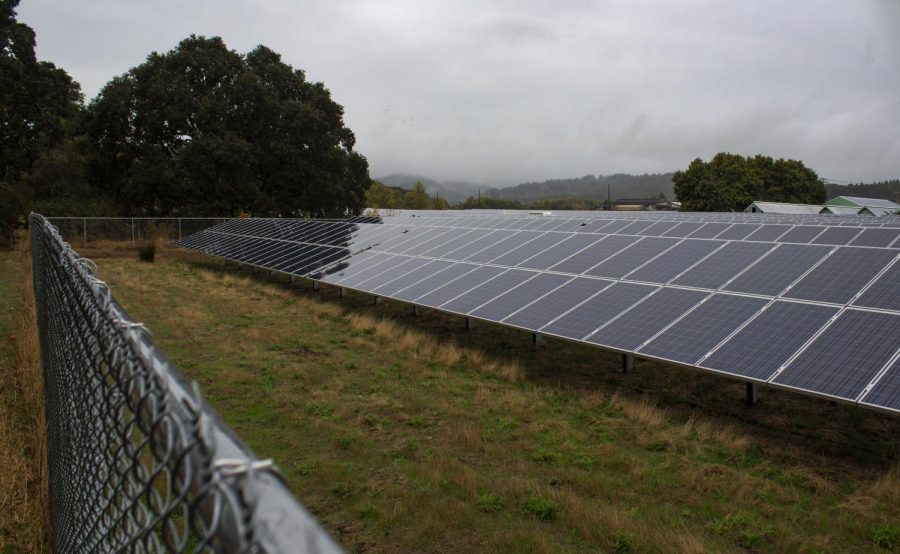OSU consistently ranks among most sustainable universities in the nation
The SW 35th Street solar array installation on September 27th in Corvallis, Ore. Sierra Magazine ranked Oregon State University at the 26th position out of 328 colleges in the country for sustainability.
October 5, 2021
Energy efficiency, sustainable food procurement and solar array maintenance: these are just three categories of the work that goes on in the Sustainability Office at Oregon State University.
Minutes before meeting for an interview, Brandon Trelstad was in the field responding to a maintenance request for the solar array just off of 35th St. on the west side of the OSU campus.
Trelstad is the sustainability officer for OSU and has been leading the efforts that has landed the university in the 26th spot out of more than 300 universities on the Sierra Club’s annual list of Cool Schools, an award based on North American universities’ initiatives on the multifaceted aspects of sustainability.
“The word [sustainability] has been redefined in so many ways…” Trelstad said. “There’s the classical definition of the three-legged stool: meeting the needs of today without compromising future generations’ ability to meet their needs. I think that is increasingly important as we enter the era of climate change impacts, knowing that what we do today has a definite and now more measurable impact on future generations.”
OSU has been reporting data to the Sustainability Tracking Assessment and Rating System program for upwards of ten years, making it the organization’s most consistent and longest-standing reporter of data. STARS is an accredited data reporting tool that gives a tangible and transparent rating of universities’ carbon footprint and overall sustainability. The data reported is available for anybody to check out, making it easy for OSU to get recognized for its efforts.
“A lot of schools only report every two or three years—we report every year, in part because I’m a strong believer in the old adage that you can’t manage what you don’t measure,” Trelstad said. “It’s a lot of work, but we get accolades for doing it, so why [wouldn’t] we do it?”
Consistent reporting to STARS, according to Trelstad, is not only what’s given OSU recognition for its sustainability initiatives, but has allowed the OSU sustainability department useful feedback year after year about what areas to focus on in order to get closer to carbon neutrality. Based on the data reported to STARS, OSU creates its annual sustainability report, available to check out online.
OSU has attained the gold certification from STARS, and with a large focus on incentivizing energy efficiency and water efficiency of buildings on campus, the sustainability department is hopeful that they can attain platinum certification in the near future.
Another detail that makes OSU’s sustainability-consciousness commendable, according to Trelstad, is the sustainability double degree program. Unlike other institutions, OSU’s sustainability double degree has virtually no restrictions to combine with a student’s primary degree, making it a great way for students to engage with and incorporate the many aspects of sustainability into their studies.
OSU student Lane Walter serves as the student policy coordinator in the Sustainability Office and studies chemical engineering. Walter began as an “Eco Rep” for their residence hall last year and now gets to work directly with the OSU faculty senate and experts in various sustainability-related fields in the creation of sustainability policies.
“A lot of [what makes OSU stand out from other universities] is that we have an established office of sustainability who keeps up with our reports every single year,” Walter said. “I sometimes get bogged down by the fact that there’s so much work to do, but in the grand scheme of things, OSU is doing really well in terms of efficiency and recognitions like the Sierra Club.”
Although OSU is doing well in energy efficiency and infrastructure, there’s still work to be done and areas to improve upon, according to Lily Butler, a student who serves as an outreach program assistant for Materials Management at OSU.
“Sustainability is reflected at all levels of OSU, often featuring as a key goal of the institution. I think OSU could do a much better job of centering the issue of consumption in their sustainability efforts,” Butler said. “98% of an item’s carbon footprint comes from its production and consumption, so by making purchasing guidelines that align more with OSU’s commitment to be carbon neutral, they might be able to reach their goals faster.”
OSU will continue to report its data to STARS and continue with its efforts to make sure sustainability, carbon neutrality and intergenerational equity remain priorities.
“There are also a lot of efforts I’ve seen at other universities that I think OSU should implement, like requiring everyone to have their own reusable bottle for drink purchases and only selling drinks in metal cans as opposed to plastic bottles,” Butler said. “OSU also has a lot of work to do in terms of environmental and racial justice on campus.”
























































































































